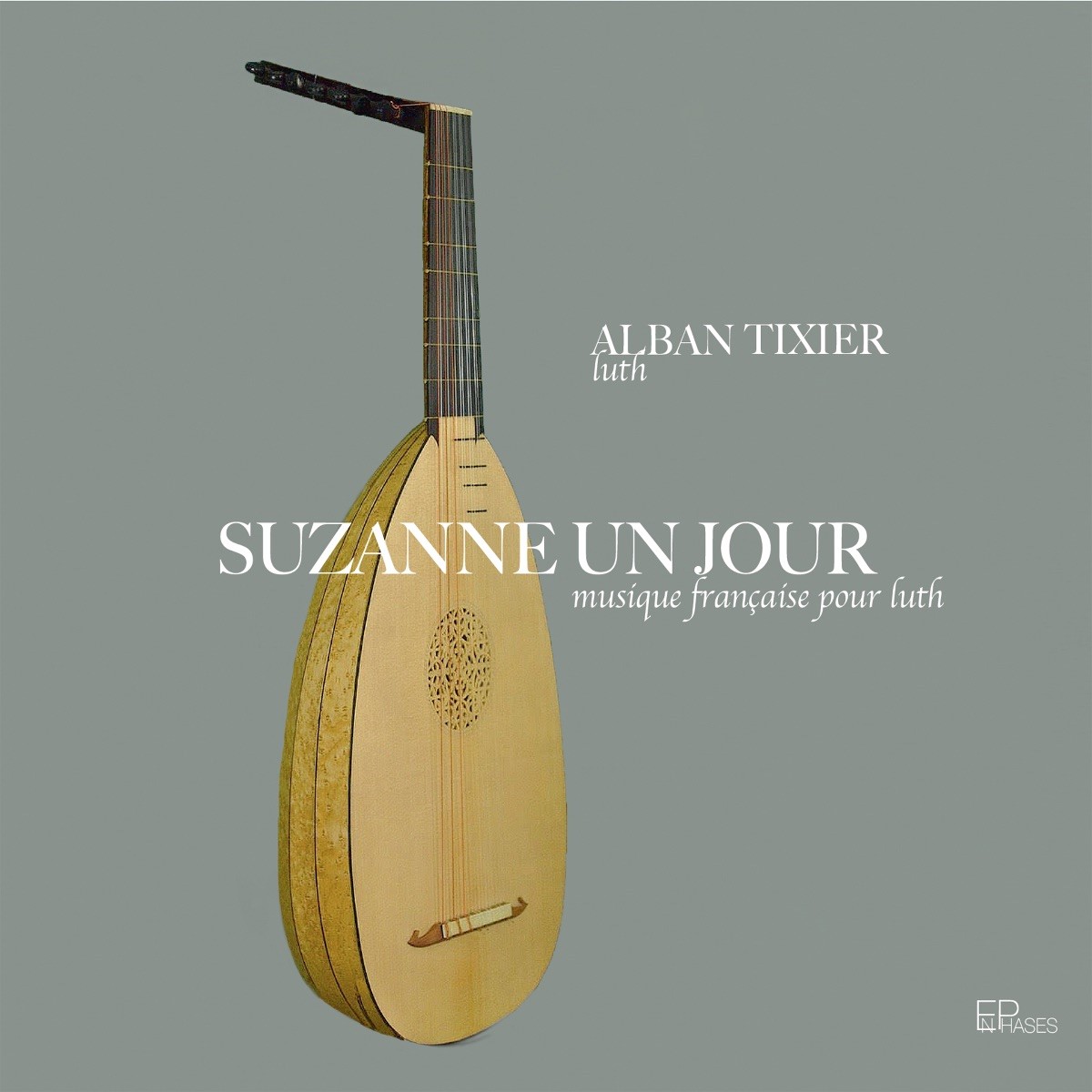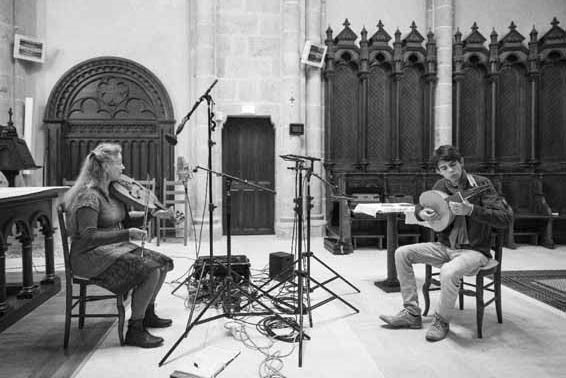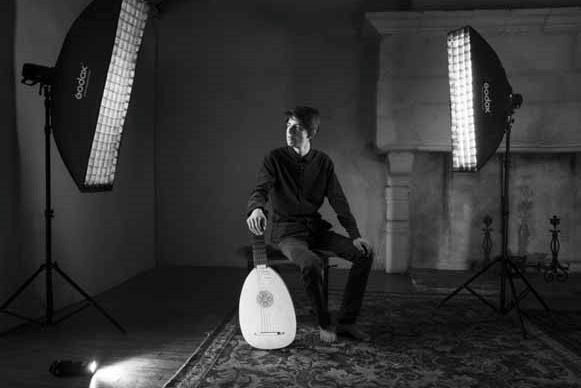Suzanne un jour

Suzanne un jour - Alban Tixier
French music for lute
1 CD Label ENPHASES (ENP016) Released on 26/04/2024
Distribution OUTHERE
Alban Tixier - Lute
Evelyne Moser - Voices and bowed fiddle, track 13
Laurent Tixier - Voices, tracks 6 and 18
Recording: 16 - 20 October 2023 - Chapelle des Pères Montfortins Saint Laurent sur Sèvre
Sound recording / Artistic direction / Editing
Franck Jaffrès / Unik Access
1. Pavane - Claude Gervaise XVIe
2. Passemèze - Adrien Le Roy XVe
3. "Can l'erba fresch" - Bernard de Ventadour XIIIe
4. Saltarello Zorzi - Anonyme XVIe
5. Basse-dance "Celle qui m'a le nom d'ami donné" - Pierre Attaignant XVIe
6. "Mignonne allons voir" - Pierre de Ronsard XVIe / Je sers une cruelle - Robert Ballard XVIIe
7. Alemande "D'Amours" - Pierre Phalèse XVIe
8. "La Souris" - Adrien Le Roy XVIe
9. Basse-dance "La Magdalena" - Pierre Attaignant XVIe / Tourdion - Anonyme XVIe / Gaillarde - Pierre Attaignant XVIe
10. Pavane - Pierre Attaignant XVIe
11. Branle "Pinagay" - Thoinot Arbeau XVIe
12. Branle "Les Pois" - Thoinot Arbeau XVIe
13. "Can vei los pratz verdesir" - Anonyme XIIIe, mélodie de Peirol (XIIe ) / "Tan m'abelis" - Berenguer de Palou XIIe
14. Pavane "Lesquercarde" - Pierre Phalèse XVIe / Courante - Maubuisson XVIe
15. Branle "Mari je songeois" - Pierre Attaignant XVIe / Courante - Pierre Attaignant XVIe
16. Basse-dance - "La Roque" Pierre Attaigant XVIe
17. Volte 1 et Volte 2 - Praetorius XVIIe
18. "Vivons" - Anonyme XVIIe
19 "Can vei la lauzeta" - Bernard de Ventadour XIIIe
20. Gaillarde de la Passemèze - Nicolas Vallet XVIIe
21. Branle - Claude Gervaise XVIe / Branle "Petit Homme" - Pierre Phalèse XVIe
22. Basse-dance - "La Brosse" Pierre Attaignant XVIe / Branle "Coupé" - Pierre Phalèze XVIe 23 "Suzanne un jour" - Didier Lupi XVIe
24. Branle "Gay" - Pierre Phalèse XVIe
25. "Gift to the fall" - Gilbert Isbin XXIe

THE INTIMACY OF THE LUTE
Here we are in the 21st century, and it's only in the last few decades that the European lute has regained a long-lost popularity. With the passage of time, playing the instrument is no longer the preserve of a few guitarists curious about what were once prestigious instruments: it can now be practised from childhood onwards. Alban Tixier is one of these 'children of the lute', who become lutenists not because they have moved away from their first instrument, but because they have somehow 'fallen into it'.
One might consider this development to be of little importance, since the lute remains a little-known instrument today. However, in my opinion, it is a very special bridge between eras. To clarify my point, it's easier to take the example of languages. For us, our mother tongue is not just the language in which we possess a high level of technical competence: it is the language with which we have a great intimacy, a connection that goes beyond us because it plunges into our childhood memory. And when we learn a foreign language late in life, no matter how good we are at learning it, it is unlikely that it will ever cease to be a "foreign" language altogether.
What strikes me when I listen to Alban Tixier's playing is the feeling of great intimacy with the lute. The lute is his garden, which gives depth to the bond between his instrument and himself.
It is, of course, possible to establish a deep bond with an instrument that is studied late in life, but it seems to me that this bond is of a different nature, and the depth of the bond is based more on a perceived will. In this case, there is a form of consensual exile, out of a taste for somewhere else.
This garden possessed by Alban Tixier is based on the transmission shaped by many musicians of the 'baroque movement' that flourished from the 1970s onwards. There's no point in mentioning all these musicians, but in the case of France, Pascale Boquet, current president of the Société Française de Luth, is a great performer and teacher with a breathtaking output.
Much of the repertoire assembled by Alban Tixier seems to me to be a tribute to this important figure on the lute. By making an intimate choice, he gives us, I believe, an image of his own journey, his own apprenticeship on the lute. And since his own learning is based on the transmission he has received, a filiation emerges.
The majority of this repertoire consists of dances and, with this genre associated with the intimacy I mentioned earlier, there is a great lightness and simplicity that emanates from this record. These dances were a very familiar repertoire, which it was perfectly natural to play on a daily basis, for pleasure.
And it is in this respect that listening to this record makes me think of a bridge between eras. The lute was an ideal instrument for sharing music. Students in particular often learned to play it. The lute made it possible to spend some pleasant moments, replaying familiar music at home.
This record emanates a great deal of familiarity, full of humility and without a spirit of demonstration, which makes it extremely accessible to all audiences. This is due, of course, to Alban Tixier's artistic choices, but also, I believe, to his intimate relationship with the lute.
Miguel Henry
Lute player and orchestrator

Alban Tixier
Alban is a 21-year-old lutenist.
After 11 years of learning the lute with Jean-François Deruy in the early music department of the Conservatoire de Musique de la Roche sur Yon, Alban went on to perfect his skills with Miguel Henry in several master classes, while at the same time studying the theorbo and Renaissance guitar. Then, after taking his A-levels, he decided to embark on an artistic career.
Immersed in a family artistic melting pot, Alban was propelled onto the stage, to the test of the stage, from an early age.
It was at the age of 10, at the Mont Blanc Baroque Music Festival, that Alban began his 'career' as a musician, working alongside his father and single-handedly leading a Renaissance ball with 80 dancers.
Later, with his younger sister and father, he formed a trio called the 'Tixier Trio', which performed a number of concerts, including the 'Nuits de Guise' at the Château Royal in Blois, at Meymac Abbey in Corrèze and at the Heritage Days at La Chabotterie. But there was one in particular that made the biggest impression on him, at the Rimay Nalanda Institute of Karma-Ling, in the presence of Edgar Morin, as part of the "Humanisme et mindfulness, une éducation pour le XXIe siècle" conference in 2015.
So it was at the age of 17 that, almost naturally, Alban set foot in the truly professional sphere and, as an actor and musician, joined the Diapason company, which produces the summer show "Jeux de Dames" at the Royal Abbey of Fontevraud. Since 2021, he has been playing the role of Jauffré Rudel, Eleanor of Aquitaine's trombadour, for the same company, in the show "Chant d'Ailes et Clercs de Plume", at the Royal Abbey in Nieul sur l'Autise.
Alban has also been performing as a soloist in concerts for several years: Clos Lucé in Amboise, Prieuré de la Cote in St Merd les Oussines in Corrèze, etc., as well as in Vendée, his place of residence: as part of CERA conferences, the Assises de la Sagesse, events at the Château du Boisniard, etc.
At the same time, our young lutenist is involved in recording albums:
- Album "La Fille du Verseau", with singer-harpist Cécile Corbel, released in July 2023.
- Album "Utrique Fidelis", conducted by Miguel Henry. Ensemble Les Présences, released in November 2023.
Share on your networks!
Follow us on the networks!

